WORD-STRUCTURE Morph e mic Structure o f Words



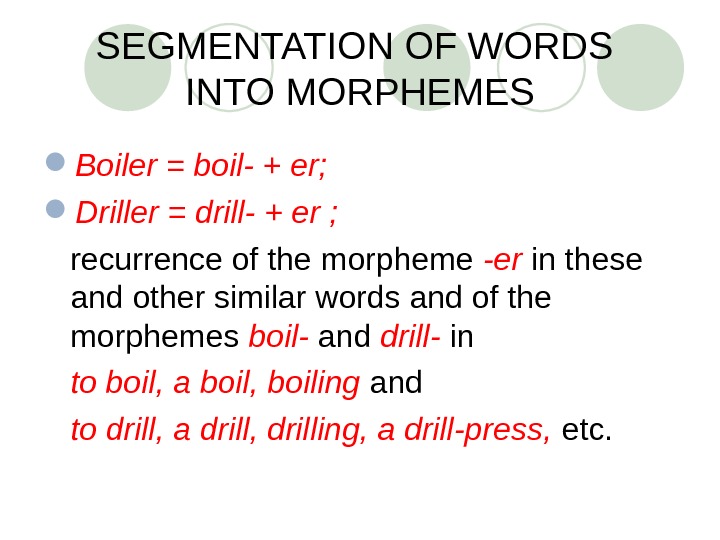
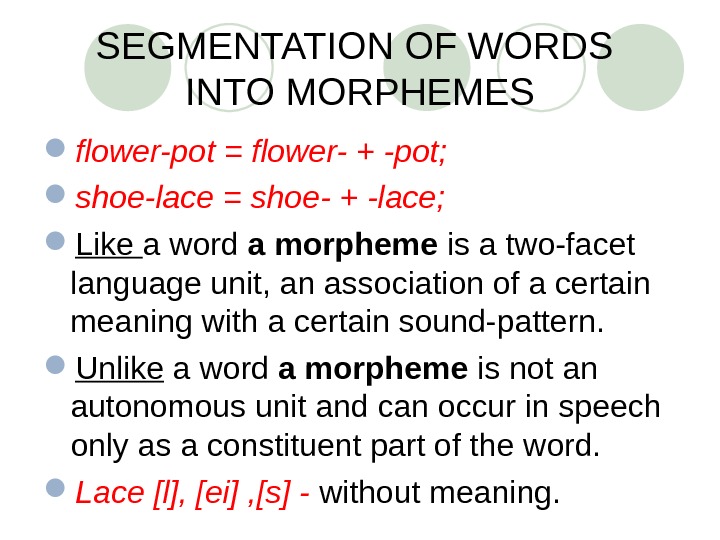



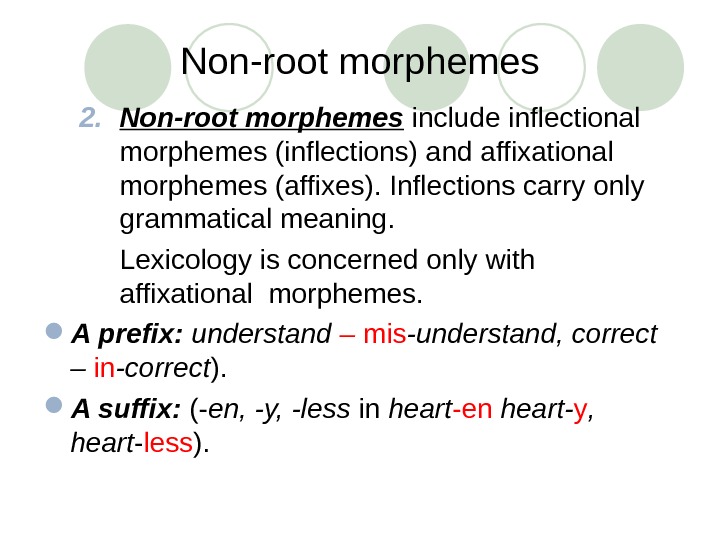



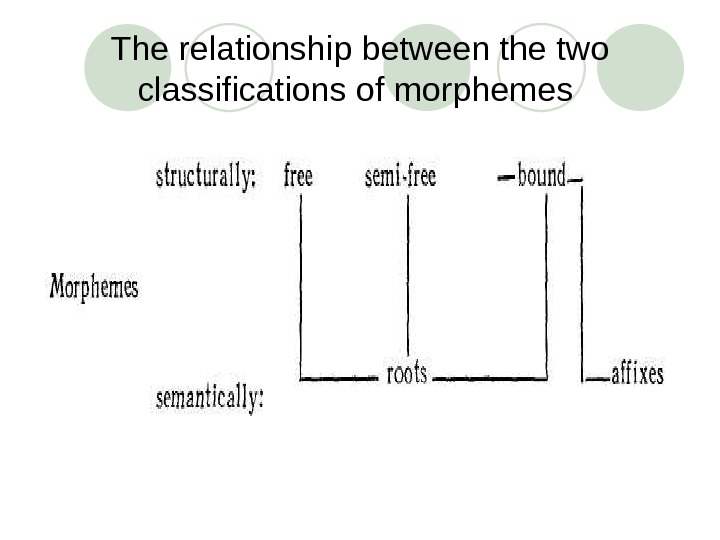





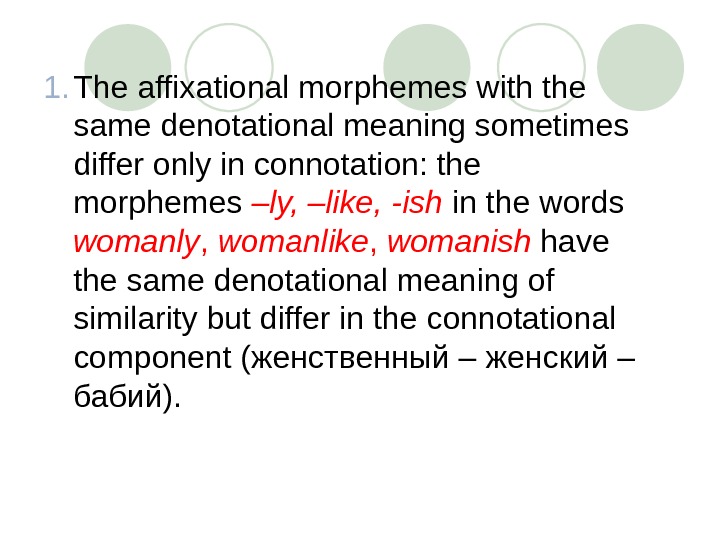




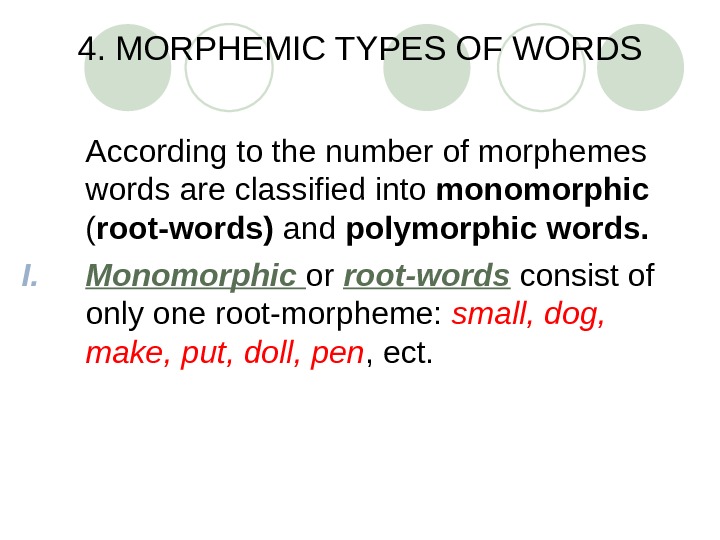






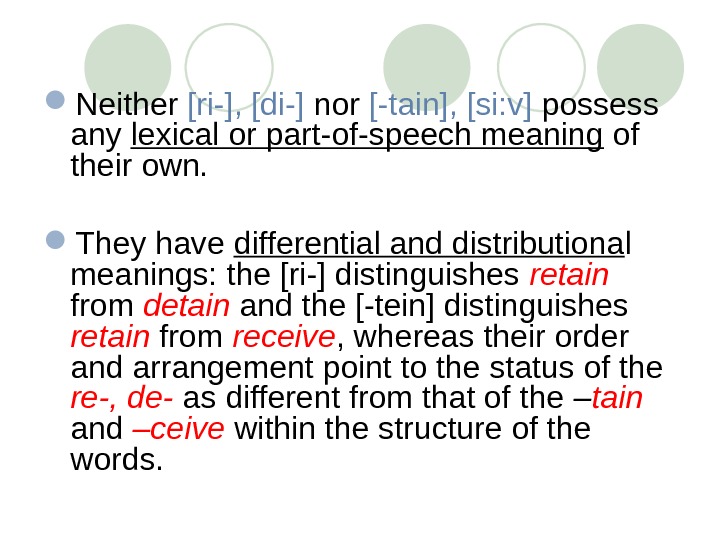





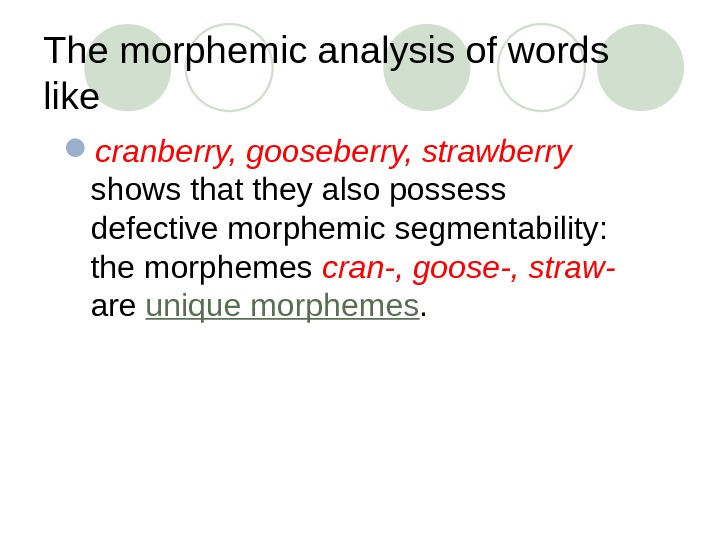


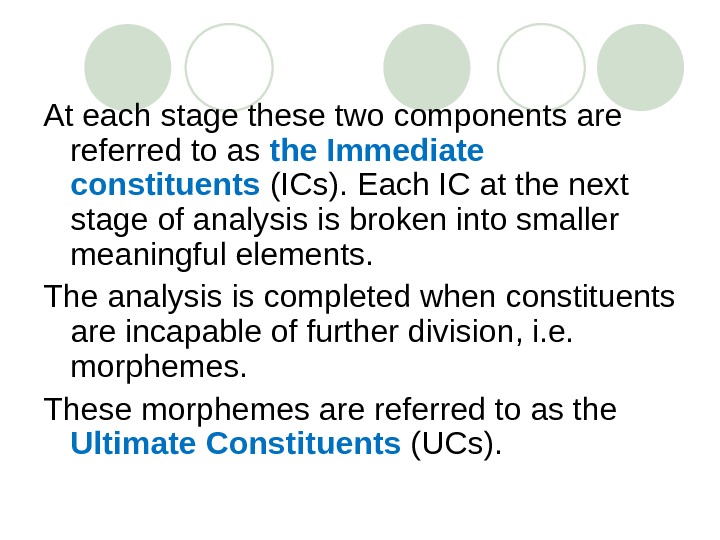
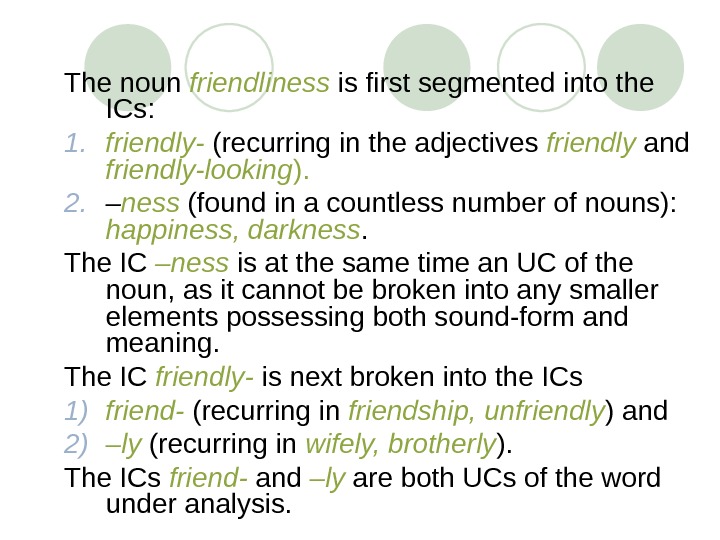

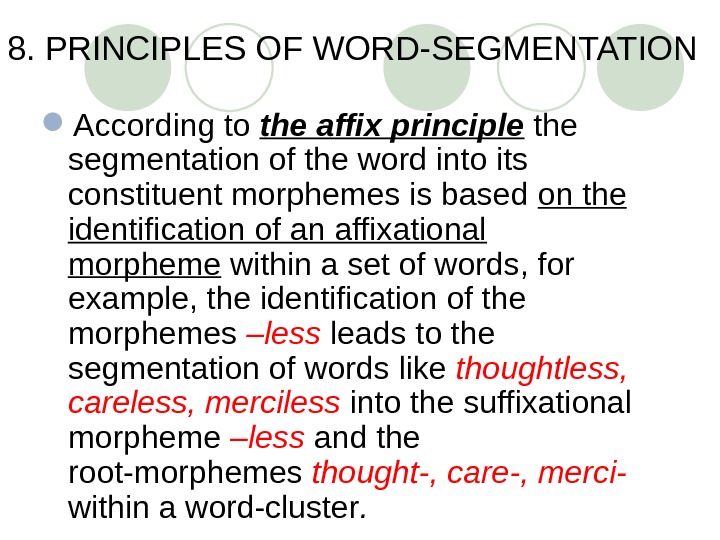



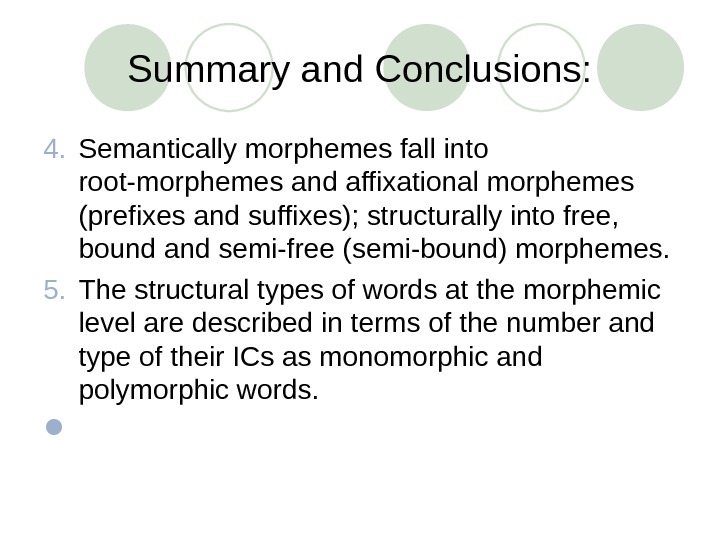

pr8_morphemic_structure_of_words.ppt
- Размер: 290 Кб
- Количество слайдов: 48
Описание презентации WORD-STRUCTURE Morph e mic Structure o f Words по слайдам
 WORD-STRUCTURE Morph e mic Structure o f Words Lecture
WORD-STRUCTURE Morph e mic Structure o f Words Lecture
 1. Word-Structure and Morphemes Morphe – ‘form’ + — eme. The Greek suffix – eme has been adopted by linguists to denote the smallest unit ( phoneme, sememe, lexeme ) Word-structure is internal organization of words. The morpheme is the smallest indivisible two-facet language unit.
1. Word-Structure and Morphemes Morphe – ‘form’ + — eme. The Greek suffix – eme has been adopted by linguists to denote the smallest unit ( phoneme, sememe, lexeme ) Word-structure is internal organization of words. The morpheme is the smallest indivisible two-facet language unit.
 MORPHEMES Morphemes cannot be segmented into smaller units without losing their constitutive essence (two-facetedness) – association of a certain meaning with a certain sound-pattern. Morphemes occur in speech only as constituent parts of words but not independently.
MORPHEMES Morphemes cannot be segmented into smaller units without losing their constitutive essence (two-facetedness) – association of a certain meaning with a certain sound-pattern. Morphemes occur in speech only as constituent parts of words but not independently.
 SEGMENTATION OF WORDS INTO MORPHEMES Boiler = boil- + er; Driller = drill- + er ; recurrence of the morpheme -er in these and other similar words and of the morphemes boil- and drill- in to boil, a boil, boiling and to drill, a drill, drilling, a drill-press, etc.
SEGMENTATION OF WORDS INTO MORPHEMES Boiler = boil- + er; Driller = drill- + er ; recurrence of the morpheme -er in these and other similar words and of the morphemes boil- and drill- in to boil, a boil, boiling and to drill, a drill, drilling, a drill-press, etc.
 SEGMENTATION OF WORDS INTO MORPHEMES flower-pot = flower- + -pot; shoe-lace = shoe- + -lace; Like a word a morpheme is a two-facet language unit, an association of a certain meaning with a certain sound-pattern. Unlike a word a morpheme is not an autonomous unit and can occur in speech only as a constituent part of the word. Lace [l], [ei] , [s] — without meaning.
SEGMENTATION OF WORDS INTO MORPHEMES flower-pot = flower- + -pot; shoe-lace = shoe- + -lace; Like a word a morpheme is a two-facet language unit, an association of a certain meaning with a certain sound-pattern. Unlike a word a morpheme is not an autonomous unit and can occur in speech only as a constituent part of the word. Lace [l], [ei] , [s] — without meaning.
![Word-cluster please pleasing pleasure pleasant [ pli: z] [pli: z] Word-cluster please pleasing pleasure pleasant [ pli: z] [pli: z]](/docs//pr8_morphemic_structure_of_words_images/pr8_morphemic_structure_of_words_5.jpg) Word-cluster please pleasing pleasure pleasant [ pli: z] [pli: z] [ple ] [plez] ʒ All the representations of the given morpheme that manifest alteration are called allomorphs of that morpheme or morpheme variants. Thus, [pli: z], [plez] and [ р l е ] ʒ are allomorphs of о n е and the same morpheme.
Word-cluster please pleasing pleasure pleasant [ pli: z] [pli: z] [ple ] [plez] ʒ All the representations of the given morpheme that manifest alteration are called allomorphs of that morpheme or morpheme variants. Thus, [pli: z], [plez] and [ р l е ] ʒ are allomorphs of о n е and the same morpheme.
![The root-morphemes in the word-clusters Duke [dju: k] , ducal ['dju: kl] , The root-morphemes in the word-clusters Duke [dju: k] , ducal ['dju: kl] ,](/docs//pr8_morphemic_structure_of_words_images/pr8_morphemic_structure_of_words_6.jpg) The root-morphemes in the word-clusters Duke [dju: k] , ducal [‘dju: kl] , duchess [‘d ˄ t iʃ ƨ ] , duchy [‘d ˄ t iʃ ] or P oor [p u ə ] , poverty [‘po v ə ti ] — are the allomorphs of one morpheme
The root-morphemes in the word-clusters Duke [dju: k] , ducal [‘dju: kl] , duchess [‘d ˄ t iʃ ƨ ] , duchy [‘d ˄ t iʃ ] or P oor [p u ə ] , poverty [‘po v ə ti ] — are the allomorphs of one morpheme
 2. 1. Semantic Classification of Morphemes 1. Root-morphemes (radicals) — the lexical nucleus of words, which has an individual lexical meaning shared by no other morpheme of the language: Helpless, handy, rewrite, hopeful, disorder Help- hand- -write hope- -order The root-morpheme is isolated as the morpheme common to a set of words making up a word-cluster: work- in to work, worker, working or theor- in theory, theorist, theoretical , etc.
2. 1. Semantic Classification of Morphemes 1. Root-morphemes (radicals) — the lexical nucleus of words, which has an individual lexical meaning shared by no other morpheme of the language: Helpless, handy, rewrite, hopeful, disorder Help- hand- -write hope- -order The root-morpheme is isolated as the morpheme common to a set of words making up a word-cluster: work- in to work, worker, working or theor- in theory, theorist, theoretical , etc.
 Non-root morphemes 2. Non-root morphemes include inflectional morphemes (inflections) and affixational morphemes (affixes). Inflections carry only grammatical meaning. Lexicology is concerned only with affixational morphemes. A prefix: understand – mis -understand, correct – in -correct ). A suffix: (- en, -y, -less in heart -en heart- y , heart — less ).
Non-root morphemes 2. Non-root morphemes include inflectional morphemes (inflections) and affixational morphemes (affixes). Inflections carry only grammatical meaning. Lexicology is concerned only with affixational morphemes. A prefix: understand – mis -understand, correct – in -correct ). A suffix: (- en, -y, -less in heart -en heart- y , heart — less ).
 2. 2. Structural Classification of Morphemes 1. A free morpheme — one that coincides with the stem or a word-form. Many root-morphemes are free morphemes , for example, use − of the noun useless is a free morpheme because it coincides with one of the forms of the noun use. 2. A bound morpheme — a morpheme that must be attached to another element. It occurs only as a constituent part of a word. Affixes are bound morphemes for they always make part of a word, for example : — ness, -ship in the words kind- ness , friend- ship ; un-, dis- in the words un -tidy, dis -like.
2. 2. Structural Classification of Morphemes 1. A free morpheme — one that coincides with the stem or a word-form. Many root-morphemes are free morphemes , for example, use − of the noun useless is a free morpheme because it coincides with one of the forms of the noun use. 2. A bound morpheme — a morpheme that must be attached to another element. It occurs only as a constituent part of a word. Affixes are bound morphemes for they always make part of a word, for example : — ness, -ship in the words kind- ness , friend- ship ; un-, dis- in the words un -tidy, dis -like.
 All unique roots and pseudo-roots are-bound morphemes. Such are the root-morphemes theor- in theory, theoretical, etc. , barbar- in barbarism, barbarian, etc. , -ceive in conceive, perceive, etc.
All unique roots and pseudo-roots are-bound morphemes. Such are the root-morphemes theor- in theory, theoretical, etc. , barbar- in barbarism, barbarian, etc. , -ceive in conceive, perceive, etc.
 3. Semi-bound (semi-free) morphemes -morphemes that can function in a morphemic sequence both as an affix and as a free morpheme: the morpheme well and half can occur as free morphemes: sing well, half a month. They can also occur as bound morphemes in words like well-known, half-eaten, half-done.
3. Semi-bound (semi-free) morphemes -morphemes that can function in a morphemic sequence both as an affix and as a free morpheme: the morpheme well and half can occur as free morphemes: sing well, half a month. They can also occur as bound morphemes in words like well-known, half-eaten, half-done.
 The relationship between the two classifications of morphemes
The relationship between the two classifications of morphemes
 Word-structure on the morphemic level: 1 st Group — Combining forms are morphemes borrowed namely from Greek or Latin in which they exist as free forms. They are considered to be bound roots : tele-phone consists of two bound roots. Phonoscope = ‘sound’ + ‘seeing’; Microscope = ‘smallness’ + ‘seeing’; Telegraph = ‘far’ + ‘writing’;
Word-structure on the morphemic level: 1 st Group — Combining forms are morphemes borrowed namely from Greek or Latin in which they exist as free forms. They are considered to be bound roots : tele-phone consists of two bound roots. Phonoscope = ‘sound’ + ‘seeing’; Microscope = ‘smallness’ + ‘seeing’; Telegraph = ‘far’ + ‘writing’;
 The 2 nd Group embraces morphemes occupying a kind of intermediate position, morphemes that are changing their class membership. Root morpheme man – in postman, fisherman, gentleman, etc. in comparison with man-made, man-servant. -man = -er; in cabman, chairman, tradesman Not a male adult But agent ! * She is an Englishman * All women are tradesmen.
The 2 nd Group embraces morphemes occupying a kind of intermediate position, morphemes that are changing their class membership. Root morpheme man – in postman, fisherman, gentleman, etc. in comparison with man-made, man-servant. -man = -er; in cabman, chairman, tradesman Not a male adult But agent ! * She is an Englishman * All women are tradesmen.
 3. TYPES OF MEANING IN MORPHEMES In morphemes can be singled out different types of meaning depending on the semantic class they belong to. 1. Root-morphemes have lexical, differential and distributional types of meaning. 2. Affixational morphemes have lexical, part of-speech, differential and distributional types of meaning. 3. Both root-morphemes and affixational morphemes are devoid of grammatical meaning.
3. TYPES OF MEANING IN MORPHEMES In morphemes can be singled out different types of meaning depending on the semantic class they belong to. 1. Root-morphemes have lexical, differential and distributional types of meaning. 2. Affixational morphemes have lexical, part of-speech, differential and distributional types of meaning. 3. Both root-morphemes and affixational morphemes are devoid of grammatical meaning.
 3. 1. LEXICAL MEANING 1. Root-morphemes have an individual lexical meaning shared by no other morphemes in the language: light, deaf, deep , etc. 2. Affixational morphemes have a more generalizing character of lexical meaning: the suffix –en carries the meaning “the change of a quality”, e. g. to lighten – to become lighter, to deafen – to make somebody deaf.
3. 1. LEXICAL MEANING 1. Root-morphemes have an individual lexical meaning shared by no other morphemes in the language: light, deaf, deep , etc. 2. Affixational morphemes have a more generalizing character of lexical meaning: the suffix –en carries the meaning “the change of a quality”, e. g. to lighten – to become lighter, to deafen – to make somebody deaf.
 Morphemes may be also analyzed into denotational and connotational components: 1. The connotational component of meaning may be found in affixational morphemes: — ette (kitchenette) ; -ie (dearie, girlie) ; -ling (duckling ) bear a heavy emotive charge.
Morphemes may be also analyzed into denotational and connotational components: 1. The connotational component of meaning may be found in affixational morphemes: — ette (kitchenette) ; -ie (dearie, girlie) ; -ling (duckling ) bear a heavy emotive charge.
 1. The affixational morphemes with the same denotational meaning sometimes differ only in connotation: the morphemes –ly, –like, -ish in the words womanly , womanlike , womanish have the same denotational meaning of similarity but differ in the connotational component ( женственный – женский – бабий ).
1. The affixational morphemes with the same denotational meaning sometimes differ only in connotation: the morphemes –ly, –like, -ish in the words womanly , womanlike , womanish have the same denotational meaning of similarity but differ in the connotational component ( женственный – женский – бабий ).
 Stylistic reference may be found in morphemes of different types: the affixational morphemes – — ine ( chlorine ), -oid ( rhomboid) are bookish.
Stylistic reference may be found in morphemes of different types: the affixational morphemes – — ine ( chlorine ), -oid ( rhomboid) are bookish.
 3. 2. DIFFERENTIAL MEANING Differential meaning is the semantic component that serves to distinguish one word from all others containing identical morphemes. In words consisting of two or more morphemes, one of the constituent morphemes always has differential meaning: in the word forehead the morpheme – head serves to distinguish the word from other words containing the morpheme fore — : forefoot, forepart, foreground.
3. 2. DIFFERENTIAL MEANING Differential meaning is the semantic component that serves to distinguish one word from all others containing identical morphemes. In words consisting of two or more morphemes, one of the constituent morphemes always has differential meaning: in the word forehead the morpheme – head serves to distinguish the word from other words containing the morpheme fore — : forefoot, forepart, foreground.
 3. 2. DISTRIBUTIONAL MEANING Distributional meaning is the meaning of the order and arrangement of morphemes making up the word. It is found in all words containing more than one morpheme: the word teacher is composed of two morphemes teach- and –er both of which possess the denotational meaning ‘to help students to learn something’ and ‘the doer of the action’. A different arrangement of the same morphemes * erteach would make the word meaningless.
3. 2. DISTRIBUTIONAL MEANING Distributional meaning is the meaning of the order and arrangement of morphemes making up the word. It is found in all words containing more than one morpheme: the word teacher is composed of two morphemes teach- and –er both of which possess the denotational meaning ‘to help students to learn something’ and ‘the doer of the action’. A different arrangement of the same morphemes * erteach would make the word meaningless.
 3. 4. PART-OF-SPEECH MEANING Part-of-speech meaning is the indicative of the part of speech to which a derivational word belongs: the affixational morpheme – ness (darkness ) is used to form nouns, while the affixational morpheme –less (careless ) forms adjectives. Sometimes the part-of-speech meaning of morphemes predominates: the morpheme –ice in the word justice serves principally to transfer the part-of-speech meaning of the morpheme just- into another class and namely that of the noun.
3. 4. PART-OF-SPEECH MEANING Part-of-speech meaning is the indicative of the part of speech to which a derivational word belongs: the affixational morpheme – ness (darkness ) is used to form nouns, while the affixational morpheme –less (careless ) forms adjectives. Sometimes the part-of-speech meaning of morphemes predominates: the morpheme –ice in the word justice serves principally to transfer the part-of-speech meaning of the morpheme just- into another class and namely that of the noun.
 4. MORPHEMIC TYPES OF WORDS According to the number of morphemes words are classified into monomorphic ( root-words) and polymorphic words. I. Monomorphic or root-words consist of only one root-morpheme: small, dog, make, put, doll, pen , ect.
4. MORPHEMIC TYPES OF WORDS According to the number of morphemes words are classified into monomorphic ( root-words) and polymorphic words. I. Monomorphic or root-words consist of only one root-morpheme: small, dog, make, put, doll, pen , ect.
 II. Polymorphic words according to the number of root-morphemes are classified into: 1. Monoradical words (having one-root morpheme) fall into three subtypes: a) radical-suffixal word s , i. e. words consisting of one root-morpheme and two or more suffixal morphemes, for example, respectability ; b) radical-prefixal word s , i. e. words consisting of one root-morpheme and a prefixal morpheme, for example, overcome , unbutton ; c) prefixo-radical-suffixal words , i. e. words which consist of one root, prefixal and suffixal morphemes (e. g. unforgettable, misinterpretation ).
II. Polymorphic words according to the number of root-morphemes are classified into: 1. Monoradical words (having one-root morpheme) fall into three subtypes: a) radical-suffixal word s , i. e. words consisting of one root-morpheme and two or more suffixal morphemes, for example, respectability ; b) radical-prefixal word s , i. e. words consisting of one root-morpheme and a prefixal morpheme, for example, overcome , unbutton ; c) prefixo-radical-suffixal words , i. e. words which consist of one root, prefixal and suffixal morphemes (e. g. unforgettable, misinterpretation ).
 2. Polyradical words (having words consisting of two or more roots) fall into two subtypes: a) polyradical words which consist of two or more roots with no affixational morpheme, for example, pen-friend, copybook ; b) polyradical words which contain at least two roots and one or more affixational morpheme, for instance, safety-pin, light-mindedness, pen-holder.
2. Polyradical words (having words consisting of two or more roots) fall into two subtypes: a) polyradical words which consist of two or more roots with no affixational morpheme, for example, pen-friend, copybook ; b) polyradical words which contain at least two roots and one or more affixational morpheme, for instance, safety-pin, light-mindedness, pen-holder.
 5. TYPES OF WORD-SEGMENTABILITY Word-segmentability is the division of words into morphemes. Three types of morphemic segmentability of words are distinguished: 1. complete, 2. conditional, 3. defective.
5. TYPES OF WORD-SEGMENTABILITY Word-segmentability is the division of words into morphemes. Three types of morphemic segmentability of words are distinguished: 1. complete, 2. conditional, 3. defective.
 5. 1. COMPLETE SEGMENTABILITY Complete segmentability is characteristic of words, the morphemic structure of which is transparent enough, as their individual morphemes clearly stand out within the word and can be easily isolated.
5. 1. COMPLETE SEGMENTABILITY Complete segmentability is characteristic of words, the morphemic structure of which is transparent enough, as their individual morphemes clearly stand out within the word and can be easily isolated.
 The morphemes making up words of complete segmentability are called morpheme proper or full morphemes The transparent morphemic structure of the segmentable words careless, stressful is conditioned by the fact that their constituent morpheme recur with the same meaning in other words: thoughtful, powerful.
The morphemes making up words of complete segmentability are called morpheme proper or full morphemes The transparent morphemic structure of the segmentable words careless, stressful is conditioned by the fact that their constituent morpheme recur with the same meaning in other words: thoughtful, powerful.
 5. 2. CONDITIONAL SEGMENTSBILITY Conditional segmentability characterizes words whose segmentation into the constituent morphemes is doubtful for semantic reasons. In the words retain, detain or deceive the sound-cluster – [ri-], [di-] seem to be singled out easily due to their recurrence in a number of words (cf. rewrite, reorganize, decode, deorganize ).
5. 2. CONDITIONAL SEGMENTSBILITY Conditional segmentability characterizes words whose segmentation into the constituent morphemes is doubtful for semantic reasons. In the words retain, detain or deceive the sound-cluster – [ri-], [di-] seem to be singled out easily due to their recurrence in a number of words (cf. rewrite, reorganize, decode, deorganize ).
![Neither [ri-], [di-] nor [-tain], [si: v] possess any lexical or part-of-speech meaning of their Neither [ri-], [di-] nor [-tain], [si: v] possess any lexical or part-of-speech meaning of their](/docs//pr8_morphemic_structure_of_words_images/pr8_morphemic_structure_of_words_30.jpg) Neither [ri-], [di-] nor [-tain], [si: v] possess any lexical or part-of-speech meaning of their own. They have differential and distributiona l meanings: the [ri-] distinguishes retain from detain and the [-tein] distinguishes retain from receive , whereas their order and arrangement point to the status of the re-, de- as different from that of the – tain and –ceive within the structure of the words.
Neither [ri-], [di-] nor [-tain], [si: v] possess any lexical or part-of-speech meaning of their own. They have differential and distributiona l meanings: the [ri-] distinguishes retain from detain and the [-tein] distinguishes retain from receive , whereas their order and arrangement point to the status of the re-, de- as different from that of the – tain and –ceive within the structure of the words.
 The morphemes making up words of conditional segmentability do not rise to the status of full morphemes for semantic reason and that is why are called pseudo-morphemes or quasi-morphemes.
The morphemes making up words of conditional segmentability do not rise to the status of full morphemes for semantic reason and that is why are called pseudo-morphemes or quasi-morphemes.
 5. 3. DEFECTIVE SEGMENTABILITY Defective segmentability is the property of words whose component morphemes seldom or never recur in other words. One of the component morphemes of these words is a unique morpheme, which is isolated and understood as meaningful because the constituent morphemes display a more or less clear denotational meaning. In streamlet, ringlet, leaflet the morpheme –let has diminutive meaning.
5. 3. DEFECTIVE SEGMENTABILITY Defective segmentability is the property of words whose component morphemes seldom or never recur in other words. One of the component morphemes of these words is a unique morpheme, which is isolated and understood as meaningful because the constituent morphemes display a more or less clear denotational meaning. In streamlet, ringlet, leaflet the morpheme –let has diminutive meaning.
 In the word hamlet деревушка the morpheme — let has the meaning of diminutiveness. This morpheme occurs in the words ringlet, leaflet, streamlet. The sound-cluster [hæm-] does not recur in any other English word. The morpheme ham- carries a differential and distributional meaning as it distinguishes hamlet from streamlet, ringlet.
In the word hamlet деревушка the morpheme — let has the meaning of diminutiveness. This morpheme occurs in the words ringlet, leaflet, streamlet. The sound-cluster [hæm-] does not recur in any other English word. The morpheme ham- carries a differential and distributional meaning as it distinguishes hamlet from streamlet, ringlet.
 comparison with words Locket медальон , lionet, cellaret погребец , etc. leads one to the isolation of the morpheme -et having a diminutive meaning, the more so that the morphemes lock-, lion-, cellar- , etc. recur in other words: (cf. lock, locky; lion, lioness; cellar, cellarage).
comparison with words Locket медальон , lionet, cellaret погребец , etc. leads one to the isolation of the morpheme -et having a diminutive meaning, the more so that the morphemes lock-, lion-, cellar- , etc. recur in other words: (cf. lock, locky; lion, lioness; cellar, cellarage).
 The isolation of the morpheme -et leaves in the word pocket the sound-cluster [ ро k ] that does not occur in any other word of Modern English. The morpheme [ ро k ] clearly carries a differential and distributional meaning as it distinguishes pocket from the words mentioned above and thus must be qualified as a unique morpheme.
The isolation of the morpheme -et leaves in the word pocket the sound-cluster [ ро k ] that does not occur in any other word of Modern English. The morpheme [ ро k ] clearly carries a differential and distributional meaning as it distinguishes pocket from the words mentioned above and thus must be qualified as a unique morpheme.
 The morphemic analysis of words like cranberry, gooseberry, strawberry shows that they also possess defective morphemic segmentability: the morphemes cran-, goose-, straw- are unique morphemes.
The morphemic analysis of words like cranberry, gooseberry, strawberry shows that they also possess defective morphemic segmentability: the morphemes cran-, goose-, straw- are unique morphemes.
 on the level of morphemic analysis the linguist has to operate with two types of elementary units, namely full morphemes and pseudo-(quasi-)morphemes. A considerable percentage of words of conditional and defective segmentability signals a relatively complex character of the morphological system of the language, reveals the existence of various heterogeneous layers in its vocabulary.
on the level of morphemic analysis the linguist has to operate with two types of elementary units, namely full morphemes and pseudo-(quasi-)morphemes. A considerable percentage of words of conditional and defective segmentability signals a relatively complex character of the morphological system of the language, reveals the existence of various heterogeneous layers in its vocabulary.
 7. PROCEDURE OF MORPHEMIC ANALYSIS The procedure of segmenting words into the constituent morphemes is known as the method of Immediate and Ultimate Constituents (any of two meaningful parts forming a larger linguistic unit. L. Bloomfield). It is based on a binary principle, i. e. each stage of the procedure involves two components the word immediately breaks into.
7. PROCEDURE OF MORPHEMIC ANALYSIS The procedure of segmenting words into the constituent morphemes is known as the method of Immediate and Ultimate Constituents (any of two meaningful parts forming a larger linguistic unit. L. Bloomfield). It is based on a binary principle, i. e. each stage of the procedure involves two components the word immediately breaks into.
 At each stage these two components are referred to as the Immediate constituents (ICs). Each IC at the next stage of analysis is broken into smaller meaningful elements. The analysis is completed when constituents are incapable of further division, i. e. morphemes. These morphemes are referred to as the Ultimate Constituents (UCs).
At each stage these two components are referred to as the Immediate constituents (ICs). Each IC at the next stage of analysis is broken into smaller meaningful elements. The analysis is completed when constituents are incapable of further division, i. e. morphemes. These morphemes are referred to as the Ultimate Constituents (UCs).
 The noun friendliness is first segmented into the ICs: 1. friendly- (recurring in the adjectives friendly and friendly-looking ). 2. – ness (found in a countless number of nouns): happiness, darkness. The IC –ness is at the same time an UC of the noun, as it cannot be broken into any smaller elements possessing both sound-form and meaning. The IC friendly- is next broken into the ICs 1) friend- (recurring in friendship, unfriendly ) and 2) – ly (recurring in wifely, brotherly ). The ICs friend- and –ly are both UCs of the word under analysis.
The noun friendliness is first segmented into the ICs: 1. friendly- (recurring in the adjectives friendly and friendly-looking ). 2. – ness (found in a countless number of nouns): happiness, darkness. The IC –ness is at the same time an UC of the noun, as it cannot be broken into any smaller elements possessing both sound-form and meaning. The IC friendly- is next broken into the ICs 1) friend- (recurring in friendship, unfriendly ) and 2) – ly (recurring in wifely, brotherly ). The ICs friend- and –ly are both UCs of the word under analysis.
 The procedure of segmenting a word into its Ultimate Constituent morphemes
The procedure of segmenting a word into its Ultimate Constituent morphemes
 8. PRINCIPLES OF WORD-SEGMENTATION According to the affix principle the segmentation of the word into its constituent morphemes is based on the identification of an affixational morpheme within a set of words, for example, the identification of the morphemes –less leads to the segmentation of words like thoughtless, careless, merciless into the suffixational morpheme –less and the root-morphemes thought-, care-, merci- within a word-cluster.
8. PRINCIPLES OF WORD-SEGMENTATION According to the affix principle the segmentation of the word into its constituent morphemes is based on the identification of an affixational morpheme within a set of words, for example, the identification of the morphemes –less leads to the segmentation of words like thoughtless, careless, merciless into the suffixational morpheme –less and the root-morphemes thought-, care-, merci- within a word-cluster.
 According to the root principle the identification of the root-morpheme agree- in the words agreeable, agreement, disagree makes it possible to split these words into the root agree- and the affixational morphemes — able, -ment, dis-.
According to the root principle the identification of the root-morpheme agree- in the words agreeable, agreement, disagree makes it possible to split these words into the root agree- and the affixational morphemes — able, -ment, dis-.
 Summary and Conclusions: 1. There are two levels of approach to the study of word-structure: the level of morphemic analysis and the level of derivational or word-formation analysis. 2. The basic unit of the morphemic level is the morpheme defined as the smallest indivisible two-facet language unit.
Summary and Conclusions: 1. There are two levels of approach to the study of word-structure: the level of morphemic analysis and the level of derivational or word-formation analysis. 2. The basic unit of the morphemic level is the morpheme defined as the smallest indivisible two-facet language unit.
 Summary and Conclusions: 3. Three types of morphemic segmentability of words are distinguished in linguistic literature: complete, conditional and defective. Words of conditional and defective segmentability are made up of full morphemes and pseudo (quasi) morphemes. The latter do not rise to the status of full morphemes either for semantic reasons or because of their unique distribution.
Summary and Conclusions: 3. Three types of morphemic segmentability of words are distinguished in linguistic literature: complete, conditional and defective. Words of conditional and defective segmentability are made up of full morphemes and pseudo (quasi) morphemes. The latter do not rise to the status of full morphemes either for semantic reasons or because of their unique distribution.
 Summary and Conclusions: 4. Semantically morphemes fall into root-morphemes and affixational morphemes (prefixes and suffixes); structurally into free, bound and semi-free (semi-bound) morphemes. 5. The structural types of words at the morphemic level are described in terms of the number and type of their ICs as monomorphic and polymorphic words.
Summary and Conclusions: 4. Semantically morphemes fall into root-morphemes and affixational morphemes (prefixes and suffixes); structurally into free, bound and semi-free (semi-bound) morphemes. 5. The structural types of words at the morphemic level are described in terms of the number and type of their ICs as monomorphic and polymorphic words.
 References 1. Зыкова И. В. Практический курс английской лексикологии. М. : Академия, 2006. – С. 52 -56. 2. Гинзбург Р. З. Лексикология английского языка. М. : Высшая школа, 1979. – С. 89 -106. 3. Антрушина Г. Б. , Афанасьева О. В. , Морозова Н. Н. Лексикология английского языка. М. : Дрофа, 2006. – С. – 78 -128.
References 1. Зыкова И. В. Практический курс английской лексикологии. М. : Академия, 2006. – С. 52 -56. 2. Гинзбург Р. З. Лексикология английского языка. М. : Высшая школа, 1979. – С. 89 -106. 3. Антрушина Г. Б. , Афанасьева О. В. , Морозова Н. Н. Лексикология английского языка. М. : Дрофа, 2006. – С. – 78 -128.
